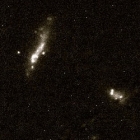The Role of Dwarf-Dwarf Interactions in the Evolution of Low Mass Galaxies
I will present the initial results from TiNy Titans, the first systematic study a sample of interacting dwarf galaxies and the mechanisms governing their star formation. Mergers of massive galaxies provide a significant mode of galaxy evolution and are observed to inspire intense starbursts and significant rearranging of the galaxies' gas and dust. However, despite the fact that mergers among low mass galaxies outnumber those between massive ones, whether these effects occur in the shallower gravitational potential wells of dwarf galaxies remains completely unconstrained. A few intriguing examples of dwarf-dwarf interactions exist in the literature, but the efficiency of gas removal and the enhancement of star formation in dwarfs via pre-processing (i.e. dwarf-dwarf interactions occurring before the accretion by a massive host) has never been studied for a uniform sample of dwarfs. Our multiwavelength approach gathers high resolution optical, UV, and radio imaging to probe the effects of interactions on the star formation and ISM in a complete sample of dwarf pairs selected from the Sloan Digital Sky Survey. We find star formation is enhanced in paired dwarfs over isolated dwarfs to an even greater extent than is observed in massive galaxies, but the dwarfs involved in interactions still have large gas reservoirs (and thus capacity for future star formation). Our interacting dwarfs tend to be low metallicity and thus offer a unique window into modes of star formation that were important at earlier epochs.

